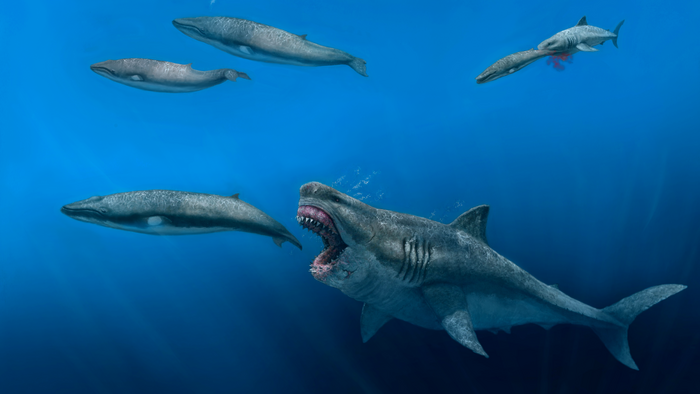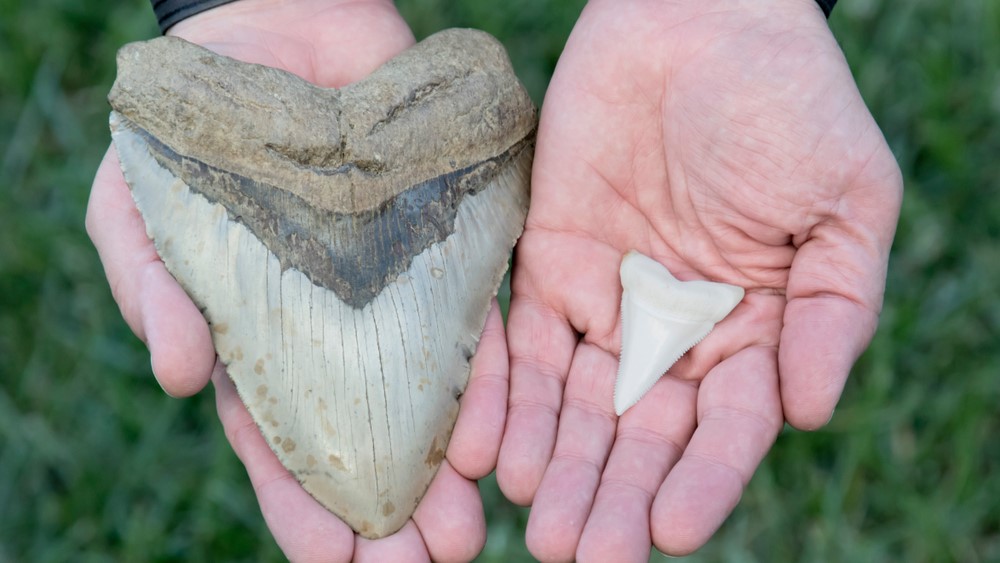Megalodon was fastest swimming shark ever and could devour an orca in 5 bites, 3D model reveals
The enormous "superpredators" may have weighed around 68 tons.

The megalodon shark was so big and powerful it could devour an orca in a few bites, and was the fastest cruising shark to ever swim the oceans, a new study shows. The finds were revealed thanks to a new 3D model of the long-extinct shark, based on data collected from fossilized teeth and vertebrae, which is giving scientists the best look yet at the size, speed and diet of the infamous "superpredator."
The megalodon (Otodus megalodon) was the largest shark to ever swim through Earth's oceans. It first emerged around 23 million years ago and went extinct about 2.6 million years ago, likely due to the emergence of great white sharks. Like modern sharks, megalodon had a cartilaginous skeleton, which does not easily fossilize, so most of what we know about the ancient leviathan comes from its fossilized teeth, which are around 6 inches (15 centimeters) long, and a few well-preserved vertebrae. As a result, scientists actually know very little about this apex predator.
In the new study, researchers combined measurements from an exceptionally well-preserved vertebral column uncovered in Belgium and a set of teeth found in the U.S. to create a rough blueprint of the megalodon's skeleton. The team then used body scans of a great white shark (Carcharodon carcharias) to fill in the gaps and estimate the amount of soft tissue that would have surrounded megalodon's bones. The scientists then combined these data to create a digitally reconstructed 3D megalodon that researchers could use to peer into the secret lives of the giant beast.
Based on the model, "we estimate that an adult O. megalodon could cruise at faster absolute speeds than any shark species today and fully consume prey the size of modern apex predators," the researchers wrote in the new study, published Aug. 17 in the journal Science Advances. "Our results suggest that O. megalodon played an important ecological role as a transoceanic superpredator."
Related: 6-year-old finds megalodon tooth on UK beach
The 3D model revealed that the megalodon was likely around 52 feet (16 meters) long. For context, the world's largest living shark, the whale shark (Rhincodon typus), normally grows to a maximum length of around 33 feet (10 m) and great white sharks max out at around 16 feet (5 m) long. Past estimates had suggested that megalodon could grow to a maximum length of around 66 feet (20 m), which may still have been possible, the researchers wrote.
Based on the model, the estimated mass of the megalodon was a whopping 67.9 tons (61.6 metric tons), which is the same as around 10 African elephants. The model also showed that the giant shark's mouth was likely around 5.6 feet (1.7 m) wide, and its bite was between 3.9 and 5.9 feet (1.2 and 1.8 m) high, depending on how wide it opened its jaw.
Sign up for the Live Science daily newsletter now
Get the world’s most fascinating discoveries delivered straight to your inbox.
After working out the megalodon's size and mass, the researchers then compared it with 28 species of living sharks to estimate how quickly it could swim. The results showed that the megalodon could theoretically travel at an average cruising speed of around 3.1 mph (5 km/h), which is faster than any living shark. However, it is unclear what its maximum speed may have been.
Estimating the size of the megalodon also helped the researchers to gain a better understanding of the enormous predator's diet.

If the megalodon's stomach took up a similar proportion of its body as the stomachs of living apex sharks, such as great whites, the team thinks the behemoth's belly could have had a volume of around 2,537 gallons (9,605 liters), which is the equivalent to around 60 bathtubs.
Therefore, the largest prey item the megalodon could consume on an empty stomach was probably anything similar in size to living orcas (Orcinus orca), which can grow to around 26 feet (8 m) long and weigh around 6.6 tons (6 metric tons). Given the size of the megalodon's massive mouth, the gigantic predator could have consumed prey this large in as few as five bites, according to the study.
The megalodon may also have hunted larger prey, but if it did, it would have been unable to eat the entirety of its meal — in which case it may have chosen to eat the best parts. For example, previous research suggested that the megalodon may have taken bites of sperm whales' faces rather than eating the entire animal.
However, it is unlikely that the megalodon would have to eat such large meals very often.
Based on its size and swimming speed, the researchers estimate that the megalodon would have used around 98,000 calories every day, which is around 20 times more than a great white shark requires. That may seem like an awful lot of food, but it isn't as much as you might think. The megalodon likely fed predominantly on cetaceans, which have big reserves of energy-rich blubber, and other sharks, which have massive, fatty livers that help them float. Therefore, eating something as large as an orca would have provided the megalodon with all the energy it needed for around two months and maybe more, according to the study.
The researchers think that these infrequent but massive meals could have sustained the megalodon during massive transoceanic migrations, which it would have completed in record times due to its zippy cruising speed. These massive trips across the world likely enabled the gigantic sharks to dominate the ancient oceans, the researchers wrote.
Originally published on Live Science.

Harry is a U.K.-based senior staff writer at Live Science. He studied marine biology at the University of Exeter before training to become a journalist. He covers a wide range of topics including space exploration, planetary science, space weather, climate change, animal behavior and paleontology. His recent work on the solar maximum won "best space submission" at the 2024 Aerospace Media Awards and was shortlisted in the "top scoop" category at the NCTJ Awards for Excellence in 2023. He also writes Live Science's weekly Earth from space series.









